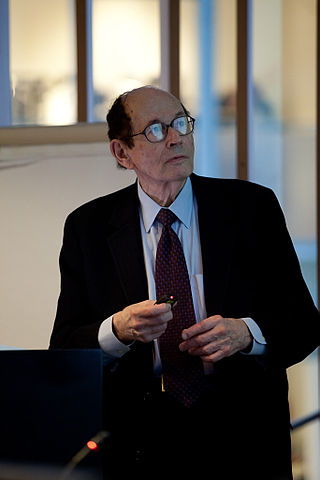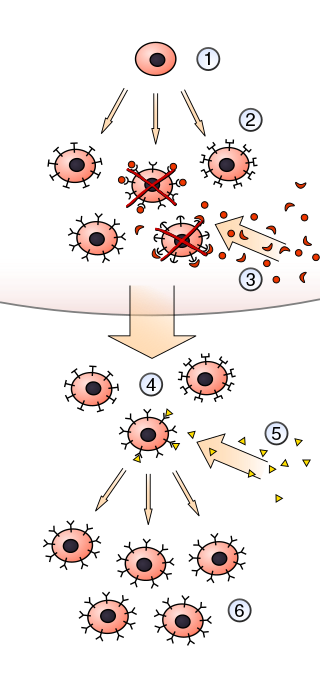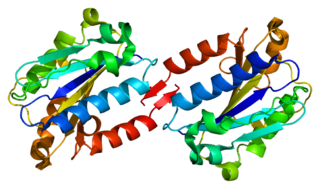Related Research Articles
An abzyme, also called catmab, and most often called catalytic antibody or sometimes catab, is a monoclonal antibody with catalytic activity. Abzymes are usually raised in lab animals immunized against synthetic haptens, but some natural abzymes can be found in normal humans and in patients with autoimmune diseases such as systemic lupus erythematosus, where they can bind to and hydrolyze DNA. To date abzymes display only weak, modest catalytic activity and have not proved to be of any practical use. They are, however, subjects of considerable academic interest. Studying them has yielded important insights into reaction mechanisms, enzyme structure and function, catalysis, and the immune system itself.

The immune system is a network of biological systems that protects an organism from diseases. It detects and responds to a wide variety of pathogens, from viruses to parasitic worms, as well as cancer cells and objects such as wood splinters, distinguishing them from the organism's own healthy tissue. Many species have two major subsystems of the immune system. The innate immune system provides a preconfigured response to broad groups of situations and stimuli. The adaptive immune system provides a tailored response to each stimulus by learning to recognize molecules it has previously encountered. Both use molecules and cells to perform their functions.

Immunology is a branch of biology and medicine that covers the study of immune systems in all organisms.

Neural Darwinism is a biological, and more specifically Darwinian and selectionist, approach to understanding global brain function, originally proposed by American biologist, researcher and Nobel-Prize recipient Gerald Maurice Edelman. Edelman's 1987 book Neural Darwinism introduced the public to the theory of neuronal group selection (TNGS) – which is the core theory underlying Edelman's explanation of global brain function.

In immunology, autoimmunity is the system of immune responses of an organism against its own healthy cells, tissues and other normal body constituents. Any disease resulting from this type of immune response is termed an "autoimmune disease". Prominent examples include celiac disease, post-infectious IBS, diabetes mellitus type 1, Henoch–Schönlein purpura (HSP) sarcoidosis, systemic lupus erythematosus (SLE), Sjögren syndrome, eosinophilic granulomatosis with polyangiitis, Hashimoto's thyroiditis, Graves' disease, idiopathic thrombocytopenic purpura, Addison's disease, rheumatoid arthritis (RA), ankylosing spondylitis, polymyositis (PM), dermatomyositis (DM), and multiple sclerosis (MS). Autoimmune diseases are very often treated with steroids.

The T helper cells (Th cells), also known as CD4+ cells or CD4-positive cells, are a type of T cell that play an important role in the adaptive immune system. They aid the activity of other immune cells by releasing cytokines. They are considered essential in B cell antibody class switching, breaking cross-tolerance in dendritic cells, in the activation and growth of cytotoxic T cells, and in maximizing bactericidal activity of phagocytes such as macrophages and neutrophils. CD4+ cells are mature Th cells that express the surface protein CD4. Genetic variation in regulatory elements expressed by CD4+ cells determines susceptibility to a broad class of autoimmune diseases.

Niels Kaj Jerne, FRS was a Danish immunologist. He shared the Nobel Prize in Physiology or Medicine in 1984 with Georges J. F. Köhler and César Milstein "for theories concerning the specificity in development and control of the immune system and the discovery of the principle for production of monoclonal antibodies".
In artificial intelligence, artificial immune systems (AIS) are a class of computationally intelligent, rule-based machine learning systems inspired by the principles and processes of the vertebrate immune system. The algorithms are typically modeled after the immune system's characteristics of learning and memory for use in problem-solving.

The adaptive immune system, also known as the acquired immune system, or specific immune system is a subsystem of the immune system that is composed of specialized, systemic cells and processes that eliminate pathogens or prevent their growth. The acquired immune system is one of the two main immunity strategies found in vertebrates.

In immunology, clonal selection theory explains the functions of cells of the immune system (lymphocytes) in response to specific antigens invading the body. The concept was introduced by Australian doctor Frank Macfarlane Burnet in 1957, in an attempt to explain the great diversity of antibodies formed during initiation of the immune response. The theory has become the widely accepted model for how the human immune system responds to infection and how certain types of B and T lymphocytes are selected for destruction of specific antigens.
In academia, computational immunology is a field of science that encompasses high-throughput genomic and bioinformatics approaches to immunology. The field's main aim is to convert immunological data into computational problems, solve these problems using mathematical and computational approaches and then convert these results into immunologically meaningful interpretations.

In immunology, an Fc receptor is a protein found on the surface of certain cells – including, among others, B lymphocytes, follicular dendritic cells, natural killer cells, macrophages, neutrophils, eosinophils, basophils, human platelets, and mast cells – that contribute to the protective functions of the immune system. Its name is derived from its binding specificity for a part of an antibody known as the Fc region. Fc receptors bind to antibodies that are attached to infected cells or invading pathogens. Their activity stimulates phagocytic or cytotoxic cells to destroy microbes, or infected cells by antibody-mediated phagocytosis or antibody-dependent cell-mediated cytotoxicity. Some viruses such as flaviviruses use Fc receptors to help them infect cells, by a mechanism known as antibody-dependent enhancement of infection.
In immunology, an idiotope is the unique set of antigenic determinants (epitopes) of the variable portion of an antibody. In some cases it can be the actual antigen-binding site, and in some cases it may comprise variable region sequences outside of the antigen-binding site on the antibody itself. Thus each antibody would have multiple idiotopes; and the set of these individual idiotopes is termed the idiotype of the antibody.
The following are notable events in the Timeline of immunology:

Integrin, alpha L , also known as ITGAL, is a protein that in humans is encoded by the ITGAL gene. CD11a functions in the immune system. It is involved in cellular adhesion and costimulatory signaling. It is the target of the drug efalizumab.

In immunology, an idiotype is a shared characteristic between a group of immunoglobulin or T-cell receptor (TCR) molecules based upon the antigen binding specificity and therefore structure of their variable region. The variable region of antigen receptors of T cells (TCRs) and B cells (immunoglobulins) contain complementarity-determining regions (CDRs) with unique amino acid sequences. They define the surface and properties of the variable region, determining the antigen specificity and therefore the idiotope of the molecule. Immunoglobulins or TCRs with a shared idiotope are the same idiotype. Antibody idiotype is determined by:

CD81 molecule, also known as CD81, is a protein which in humans is encoded by the CD81 gene. It is also known as 26 kDa cell surface protein, TAPA-1, and Tetraspanin-28 (Tspan-28).

Semaphorin-4D (SEMA4D) also known as Cluster of Differentiation 100 (CD100), is a protein of the semaphorin family that in humans is encoded by the SEMA4D gene.
The immune network theory is a theory of how the adaptive immune system works, that has been developed since 1974 mainly by Niels Jerne and Geoffrey W. Hoffmann. The theory states that the immune system is an interacting network of lymphocytes and molecules that have variable (V) regions. These V regions bind not only to things that are foreign to the vertebrate, but also to other V regions within the system. The immune system is therefore seen as a network, with the components connected to each other by V-V interactions.
Gene Martin Shearer is an American immunologist who works at the National Institutes of Health (NIH). He first achieved fame for his discovery in 1974 that T lymphocytes recognized chemically modified surface antigens only in the context of self major histocompatibility complex (MHC) encoded molecules, identifying the central feature of antigen recognition by T lymphocytes known as MHC restriction. His discovery of MHC restriction using chemically modified surface antigens was simultaneous with the discovery of MHC restricted T lymphocyte recognition of virus infected cells by Rolf Zinkernagel and Peter Doherty, who received the 1996 Nobel Prize in Physiology or Medicine.
References
- ↑ G. W. Hoffmann (1974) On the Origin of the Genetic Code and the Stability of the Translation Apparatus. J. Mol. Biol., 86, 349-362
- ↑ L. Orgel (1963) The Maintenance of the Accuracy of Protein Synthesis and its Relevance to Ageing. Proc. Natl. Acad. Sci. USA, 49, 517-521
- ↑ G. W. Hoffmann (1975) The Stochastic Theory of the Origin of the Genetic Code. Annu. Rev. Phys. Chem. 26, 123-144 (H. Eyring, Ed.)
- ↑ G. W. Hoffmann (1975) A Theory of Regulation and Self-Nonself Discrimination in an Immune Network. Eur. J. Immunol. 5, 638-647
- ↑ G. W. Hoffmann (1978) Incorporation of a Non-specific T Cell Dependent Helper Factor into a Network Theory of the Regulation of the Immune Response, in “Theoretical Immunology”, G. I. Bell, A. S. Perelson, G. H. Pimbley (eds.) Marcel Dekker, N.Y. 571 602 ISBN 0-8247-6618-0
- ↑ G. W. Hoffmann (1982) The Application of Stability Criteria in Evaluating Network Regulation Models, in “Regulation of Immune Response Dynamics vol. 1”, C. DeLisi, J. Hiernaux (Eds.), CRC Press, 137-162, ISBN 0-8493-6632-1
- ↑ G. W. Hoffmann (1994) Co-selection in Immune Network Theory and in AIDS Pathogenesis. Immunol. Cell Biol., 72, 338-346
- ↑ G. W. Hoffmann, A. Cooper-Willis, M. Chow (1986) A New Symmetry: A anti-B is anti-(B-anti-A), and Reverse Enhancement. J. Immunol. 137, 61-68
- ↑ R. B. Forsyth, G. W. Hoffmann (1990) A study of auto antiidiotypes to BSA, J. Immunol., 145, 215-223
- ↑ T. A. Kion, G. W. Hoffmann (1991) Anti HIV and anti-anti-MHC Antibodies in Alloimmune and Autoimmune Mice. Science, 253, 1138-1140
- ↑ G. W. Hoffmann (1986) A Neural Network Model Based on the Analogy with the Immune System. J. Theoret. Biol., 122, 33-67
- ↑ G. W. Hoffmann, M. W. Benson, G. M. Bree, P. E. Kinahan (1986) A Teachable Neural Network Based on an Unorthodox Neuron. Physica 22D, 233-246
- ↑ M. R. Davenport, G. W. Hoffmann (1989) A Recurrent Neural Network using tri-state hidden neurons to orthogonalize the memory space. Internat. J. Neural Systems, 1, 133-141
- ↑ G. W. Hoffmann (1987) A Theory of War and a Strategy for Peace. Security Dialogue (formerly Bulletin of Peace Proposals), 18, 93-98